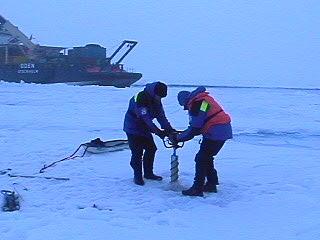19 July, 2001
Argon Gone!
Thursday, 19 July 2001
God dag! (Good day! Pronounced "goo dah!")
Life on Board
Happy Day! While I was out on the ice with the ice core drilling team, one
of the scientists shouted down to me from the ship that all of the DMS
samples had been processed and I didn't need to come off the ice to fill
the argon. I was so excited that I started jumping up and down (how
American ñ displays of such emotion!) then I decided it wasn't that good of
an idea to jump up and down on an ice sheet with 4.5 kilometers of Arctic
Ocean a few meters below.
Our flock of seagulls has left us! Only two gulls were flying around
today, skimming the water surface and occasionally diving. There seems to
be lot's of food around on the ice and in the water but no birds to eat it.
There was a big spotted seal playing around in the water next to the ship
and spyhopping to see what was happening on the ice. They are so graceful
in the water! I got a bird's eye view of it since it first appeared while
I was riding over the water in the metal basket used to transport people
and equipment onto the ice with the crane.
Where Are We Now?
This is Ice Station 13. It is cloudy but at least it has stopped raining.
Coordinates are 85o05' N by 38o07' E. Man! Are we heading north or what??
Scientists at Work
We were scheduled to arrive at a 4-hour station (Ice Station 11) last night
at midnight so I went to bed right after dinner, about 8:00 pm (20:00 hours
ship time) to get a few hours sleep. The ship was jolting around as it
plowed through the thick ice but I did sleep a little. At 11 pm, I was
awakened by a knock on my door. I got to join the ice core drilling team
on the ice for a few hours. For some reason, their research and equipment
is very interesting to me (and I get to drill the cores!). We drilled a
total of 4 cores, each about 1 meter in length on this parcticular ice floe.
They measure the total length then cut it into parts, 10 or 15 centimeter
sections, place the sections into carefully labeled buckets, and keep track
of everything in a log book (that's my duty, too). They measure the
salinity and take the temperature of the center of the core every 10
centimeters and record. They are especially interested in the bottom 5 cm
of the core where most of the organisms attach on the underside of the ice.
When we were finished, I went back on the ship and helped my group collect
water samples from the sampling rosette, then processed them for later
analysis. The oceanography team put the rosette down to 4.5 km depth here!
Wow! That's more than 2.5 miles down! I hit the sack about 4 am (sun
shining brightly) then got up for lunch and a meeting of the atmospheric
chemistry group.
We got on to our next station about 2:00 in the afternoon. It was only a
one-hour station but they wanted to get an ice core so we hurriedly got
equipment together and hit the ice. We only got one core drilled before we
had to return and the ice was so thick here that we drilled 2 meters down
and never broke through to the water. When I returned to the ship, there
were water samples to process from the CTD cast.
E-mail Hello to Bob, Sheila, Beth. Thanks for good thoughts. Mr. White and
Mr. Huss: Too bad you guys are teaching summer school while I'm just
sitting around up here in the snow - and ice - and cold - and working all
night. Hello to New Hampshire and the Sprague family, especially Davis and
Maxwell! In regards to making a donation for my satellite email service
for more time online, let me talk to my sponsors. In regards to the cold,
the Swedish Polar Research Secretariat has outfitted us all with incredible
fleece jackets, Gore-tex parkas and Gore-tex overalls. I also have
waterproof Goretex ice boots, polypro gloves and waterproof diving gloves.
Hello to Sheryle Stratton and everyone at El Capitan High School, including
Greg Hoffmaster in Tech Fundamentals class (Since I am a teacher, I must
tell you to check your spelling before sending any mail, including email!)
Vi ses! (See you later!)
From Deck 4 on the Icebreaker Oden, somewhere north of 85,
Dena Rosenberger

Drilling a core. That'a me on the right and Tuomo Roine on the left. The little sled is used to bring equipment out to the site.
Contact the TEA in the field at
.
If you cannot connect through your browser, copy the
TEA's e-mail address in the "To:" line of
your favorite e-mail package.
|
